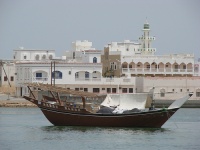 Muscat OverviewMuscat is the largest city in Oman, but the bustle of the modern
capital city is easily forgotten with rug merchants,
cannon-protected forts and an ornate sultan's palace overlooking
the historic city harbour. The once important maritime city
underwent a resurgence in the 1970s, when the Sultan Qaboos bin
Said began to develop museums, mosques, palaces, and to restore
relics of Muscat's history. Although Muscat is a popular
destination for sightseeing tourists, many of the attractions are
primarily regular fixtures of Omani life. The mosques are important
religious sites, the ancient forts are still operated by the
military and the palace is the seat of Oman's government. While
this gives visitors an authentic experience, tourists can find
playing second fiddle a little inconvenient. The beauty of the
city, especially near the harbour, is what makes Muscat so
alluring. The smooth curved stone architecture is a transition from
the rocky landscape to the inviting water of the harbour. Many new
buildings have continued with classic Arabic architecture, further
protecting the city's legacy from the ravages of the modern world.
Muscat is one of the safest, most cosmpolitan and open-minded city
in the entire Gulf Region, and is fast becoming a Middle East
tourism hotspot. |